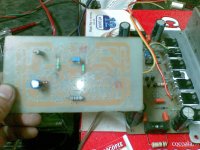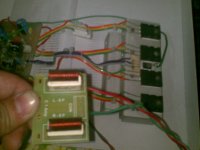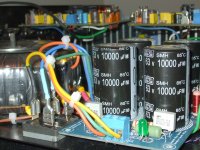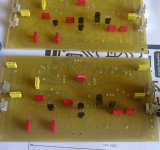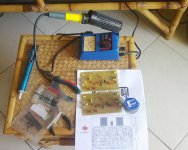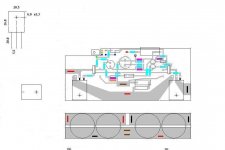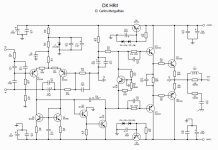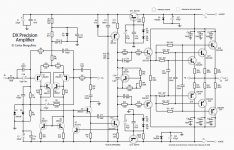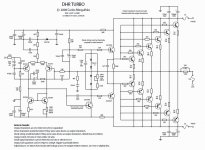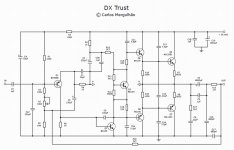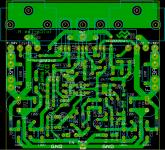Dear Carlos,
I will also build a regulated supply in the future (when projects allow) and for this I will use the PowerReg (power regulator) from Teddy Pardo, which I have used in some amplifiers with great effect: bass is huge and has lots o details...
Introducing the PowerReg - pink fish media
For it, I bought some mil spec 50V tantalum caps but it can be used with good electrolytics also. Maybe you could adapt your own Reg to include the filter part. 😎 The capacitance multiplier allows for reducing the main caps... 😉
Cheers,
M.
I will also build a regulated supply in the future (when projects allow) and for this I will use the PowerReg (power regulator) from Teddy Pardo, which I have used in some amplifiers with great effect: bass is huge and has lots o details...
Introducing the PowerReg - pink fish media
For it, I bought some mil spec 50V tantalum caps but it can be used with good electrolytics also. Maybe you could adapt your own Reg to include the filter part. 😎 The capacitance multiplier allows for reducing the main caps... 😉
Cheers,
M.
The regulator you shown is better than mine...but this one i am using since
1975 and i am sure it is good and reliable.
Reason why, i will keep mine..but thank you by the link.
I use the same Brazilian soccer team, football team...never change something that is working fine..we can try another idea and destroy all the quality we had.... so...many champioship because of this idea...my philosophy is the same..no reason to change something is working good.
regards,
Carlos
1975 and i am sure it is good and reliable.
Reason why, i will keep mine..but thank you by the link.
I use the same Brazilian soccer team, football team...never change something that is working fine..we can try another idea and destroy all the quality we had.... so...many champioship because of this idea...my philosophy is the same..no reason to change something is working good.
regards,
Carlos
Amplifiers feed by simetrical supply may send rail voltage to the output terminal
, in other words, to the speaker, if we experience some failure, some defect, some rail transistor short for instance, and other possible defects also will change the 5 milivolts off set we usually have.
That big DC voltage may destroy speakers...so, to protect, you can use sophisticated electronic circuits or fuses.
If we experience short in the upper rail, them 35 volts positive will appear in the output.... the 8 ohms speaker really will have around 6 ohms resistance to DC..... 8 ohms is impedance, to 1 Khz, and 6 ohms is resistance to DC...when DC voltage, rail voltage, 35 positive volts crosses 6 ohms, more than 5 amperes will be entering the speaker coil... so..having a fuse in series, in this case it will be a 2.5 amperes fuse...or maybe a 3 amperes fuse...even a 3.15A fuse..then it will for sure, melt.
The same will happens if you use 4 ohms speaker...maybe 3 ohms to DC...so current will be more than 10 amperes.... the 5 or 6 amperes fuse, for sure will melt in advance the speaker coil can melt.
This can fail is the guy is using 10 watts woofer with a 100 watts amplifier..well.... this way the speaker will melt...but no one is so insane .... and if the guy knows the speaker is under rated, then he deserve to have it destroyed...maybe he want to see the smoke.
We can protect the most we can, but we cannot forecast high voltage discharges from the clouds, also the guy may be drunk and will connect the speaker directly into the wall socket.
ahahahahahah!
regards,
Carlos
, in other words, to the speaker, if we experience some failure, some defect, some rail transistor short for instance, and other possible defects also will change the 5 milivolts off set we usually have.
That big DC voltage may destroy speakers...so, to protect, you can use sophisticated electronic circuits or fuses.
If we experience short in the upper rail, them 35 volts positive will appear in the output.... the 8 ohms speaker really will have around 6 ohms resistance to DC..... 8 ohms is impedance, to 1 Khz, and 6 ohms is resistance to DC...when DC voltage, rail voltage, 35 positive volts crosses 6 ohms, more than 5 amperes will be entering the speaker coil... so..having a fuse in series, in this case it will be a 2.5 amperes fuse...or maybe a 3 amperes fuse...even a 3.15A fuse..then it will for sure, melt.
The same will happens if you use 4 ohms speaker...maybe 3 ohms to DC...so current will be more than 10 amperes.... the 5 or 6 amperes fuse, for sure will melt in advance the speaker coil can melt.
This can fail is the guy is using 10 watts woofer with a 100 watts amplifier..well.... this way the speaker will melt...but no one is so insane .... and if the guy knows the speaker is under rated, then he deserve to have it destroyed...maybe he want to see the smoke.
We can protect the most we can, but we cannot forecast high voltage discharges from the clouds, also the guy may be drunk and will connect the speaker directly into the wall socket.
ahahahahahah!
regards,
Carlos
Last edited:
Good news Takku..... sounds lovely.... i cannot stand for the Dx Amplifier anymore.
The standard...i feel it unprecise in the bass, despite strong, not precise, also needs more treble.
You told speaker output.... is this from your computer?...... take the output at line out jack, less than 1 volt there and impedance is higher than speaker output jack.
Maybe they are the same in your computer....i had some mother boards written speakers and was not low impedance (8 ohms) high level output (5 to 6 volts out).
Nice board colour... interesting....brazilian ones are green, and ours detach copper lines if you apply too much heat..... not good ones..... we have several brands, some of them are no good.
And you are using wires to the output transistor...this use to unstabilize amplifiers...i see that Dx Blame ST passed the test...if survived without oscilations using wires to power transistors, then the unit is really super stable..the way i wanted.
I see you have used the correct turns to the output coil....looks nice and are separated from the main board...good!
Well, there is a picture using long wires to the output transistors...i suppose you have fixed that, because another board has not wires anymore.
Interesting, the amplifier started the way it is now a days...and oscilated!.... maybe other problems i think...i have found my VBE multiplier transistor having intermitent base contact (internal defect).... maybe this and another constrution error made the mess first time.... i had to introduce the now a days removed capacitors to make it stable... and today without the same capacitors it is stable.
This use not to be mistery, this means "errors".... i have made other errors i think.
regards,
Carlos
The standard...i feel it unprecise in the bass, despite strong, not precise, also needs more treble.
You told speaker output.... is this from your computer?...... take the output at line out jack, less than 1 volt there and impedance is higher than speaker output jack.
Maybe they are the same in your computer....i had some mother boards written speakers and was not low impedance (8 ohms) high level output (5 to 6 volts out).
Nice board colour... interesting....brazilian ones are green, and ours detach copper lines if you apply too much heat..... not good ones..... we have several brands, some of them are no good.
And you are using wires to the output transistor...this use to unstabilize amplifiers...i see that Dx Blame ST passed the test...if survived without oscilations using wires to power transistors, then the unit is really super stable..the way i wanted.
I see you have used the correct turns to the output coil....looks nice and are separated from the main board...good!
Well, there is a picture using long wires to the output transistors...i suppose you have fixed that, because another board has not wires anymore.
Interesting, the amplifier started the way it is now a days...and oscilated!.... maybe other problems i think...i have found my VBE multiplier transistor having intermitent base contact (internal defect).... maybe this and another constrution error made the mess first time.... i had to introduce the now a days removed capacitors to make it stable... and today without the same capacitors it is stable.
This use not to be mistery, this means "errors".... i have made other errors i think.
regards,
Carlos
Last edited:
Thank you Carlos, i live in Maceió, and i pretend to finish my DX BLAME
soon. I will send more pictures at the end.
best regards
hudnes
soon. I will send more pictures at the end.
best regards
hudnes
I see Bonfim, we are neighboors.... 250Km distance only
My beach looks alike yours...but we have some sharks here.
Welcome to the Dx Corporation....buiding a Dx Amplifier then you are an honored member.
Send me picture to the hall of fame.
regards,
Carlos
My beach looks alike yours...but we have some sharks here.
Welcome to the Dx Corporation....buiding a Dx Amplifier then you are an honored member.
Send me picture to the hall of fame.
regards,
Carlos
An externally hosted image should be here but it was not working when we last tested it.
Attachments
Build a Dx Blame ST - the excelence of sonics
Give to yourself this prize... you deserve it.
YouTube - Dx Blame ST - the most stable one!
regards,
Carlos
Give to yourself this prize... you deserve it.
YouTube - Dx Blame ST - the most stable one!
regards,
Carlos
Im not sure, but from your evaluation of how your amps sound, Dx standard might still be the one I would give a closer look
Maybe we only need to "destabilise" it a bit 🙄 may not even be a joke 😀
Might be interesting to look at what causes what you descibe as less precise bass, or a change in perceived level of higher frequency
Amps are linear, so we know it must something different
Maybe we only need to "destabilise" it a bit 🙄 may not even be a joke 😀
Might be interesting to look at what causes what you descibe as less precise bass, or a change in perceived level of higher frequency
Amps are linear, so we know it must something different
Yes....yesterday i was listening and comparing... the standard
sounds very nice.... flat power from 1 hertz to 60 kilohertz.... sinusoidal wave does not turns a triangle even in frequencies higher than 100 Megahertz.
But the square wave is not very good.... the rise time is not fine... 10 times slower than the Dx Blame ES...and i could see this can sound different, at least in these amplifiers.
I have found perfect square waves in other amplifiers, and sound was not fine... say... perfect specifications and perfect square waves is not a guarantee of nice sound reproduction...but for sure shows the amplifier is good and may sound good too.
Doing comparison you see how things are different..both are flat, but the Dx Amplifier has huge bass, an earthquake, thunderstorm...bass is longer than normal, not perfect, not controlled but very nice.
The Dx Blame ES has a very controled bass, present but shy when compared to the Dx Amplifier...more precise, more natural, more perfect, also nice...but sounds alike we have decreased bass control to 9 hours (flat is 12)....also treble is much more precise, detailed, focused..dinamics is superior too.
I cannot be listening the Dx Amplifier anymore...i could stand for that before i have listened this one( the Blame)....also i could be listening the Dx Standard even after have assembled and listend several thousand amplifiers..but now a days i cannot stand anymore... a friend sent me a Dx Amplifier board, and i have to assemble, because was a gift, and i am searching energy and motivation to do that...in the reality, it does not interests me anymore....but a gift, i cannot trow away, i cannot give it for others and i cannot sell... and the worse, i cannot let it the way it is..dismounted inside plastic bags...that friend not only made the board, made the whole kit of selected parts and included heatsinks and power transistors.
Dx amplifier is not something that may feel you ashamed when comparing with others, but really, the Blame brings sound to another level.
The ones have the Dx amplifier will be happy till the day they experience to listen this one..then they will not want to listen the standard anymore.
regards,
Carlos
sounds very nice.... flat power from 1 hertz to 60 kilohertz.... sinusoidal wave does not turns a triangle even in frequencies higher than 100 Megahertz.
But the square wave is not very good.... the rise time is not fine... 10 times slower than the Dx Blame ES...and i could see this can sound different, at least in these amplifiers.
I have found perfect square waves in other amplifiers, and sound was not fine... say... perfect specifications and perfect square waves is not a guarantee of nice sound reproduction...but for sure shows the amplifier is good and may sound good too.
Doing comparison you see how things are different..both are flat, but the Dx Amplifier has huge bass, an earthquake, thunderstorm...bass is longer than normal, not perfect, not controlled but very nice.
The Dx Blame ES has a very controled bass, present but shy when compared to the Dx Amplifier...more precise, more natural, more perfect, also nice...but sounds alike we have decreased bass control to 9 hours (flat is 12)....also treble is much more precise, detailed, focused..dinamics is superior too.
I cannot be listening the Dx Amplifier anymore...i could stand for that before i have listened this one( the Blame)....also i could be listening the Dx Standard even after have assembled and listend several thousand amplifiers..but now a days i cannot stand anymore... a friend sent me a Dx Amplifier board, and i have to assemble, because was a gift, and i am searching energy and motivation to do that...in the reality, it does not interests me anymore....but a gift, i cannot trow away, i cannot give it for others and i cannot sell... and the worse, i cannot let it the way it is..dismounted inside plastic bags...that friend not only made the board, made the whole kit of selected parts and included heatsinks and power transistors.
Dx amplifier is not something that may feel you ashamed when comparing with others, but really, the Blame brings sound to another level.
The ones have the Dx amplifier will be happy till the day they experience to listen this one..then they will not want to listen the standard anymore.
regards,
Carlos
Last edited:
a friend sent me a Dx Amplifier board, and i have to assemble, because was a gift, and i am searching energy and motivation to do that...in the reality, it does not interests me anymore.
Ok, I wont send you any boards then 😉
But I still will, if you gain interest to see if its different
btw, I have changed back to original output devices(Toshiba😀)
No modifications, other than no onboard supply caps/decouling
I believe this is the desired "star ground", no ?
Attachments
I am not sure...i use frame ground in my personal circuits
It seems star has a central point and several "arms"...alike a star.
I do not like to talk about theories, not only i have not good knowledge, but also i think it is not good for DIY... as we have too much people that just talk and do nothing, they pervert the forum direction in my point of view...as DIY, i suppose, means to build things, to design things, to test things....not only to talk about theories about these things.
We have too much lazy folks, doing nothing and just giving opinions, even when their opinions were not asked.... and i do not respect them, they do not evaluate using ears, listening..so..in my point of view, they have nothing to add to my life...just possibilities.... you see, their amplifiers are terrible!..so...i cannot listen them..exception is Hugh Dean products...Aspen Amplifiers products...Aksa amplifiers.
But will talk a little bit about differences between these amplifiers.... the obvious differences..
The Differencial is using CCS, this is one difference, my other amplifiers does not use CCS...also i have build, as you may know...was published..two Dx amplifiers, one using CCS and other using the zener voltage regulator...SAME SOUND, SAME MEASUREMENTS.
The differential, using current sink, was used in the Precision 1 and was used in the HRII....but they do not sound alike the Dx Blame ES.
Maybe the difference is the huge current ... 4 times bigger current in the differential and input impedance is 3 times smaller when compared to some other amplifier...but impedance is almost the same i have used in the Precision 1 and HRII...and these ones have not sounded so good as the Dx Blame ES or ST (the stable one).
I am using double VAS...two transistors, Doctor Self book style...copied!.... and i have used this same one in the HRII and also in the Precision 1.... precision 1 was wrong use..had a VI limiter to kill dinamics...used in the VAS... because pressure the theorists made with me, with their theorical terrorism, saying the amplifier will explode..when they cannot influence our decisions...then, they try to destroy your amplifier credibility.... but was not because this VAS.... HRII and Precision 1, even using this same VAS style, have not sounded so good as the Blame.
But i have made a needed modifications in this VAS..the blame has 100 ohms as first transistor colector load... was needed to share VBEs almost equal between these two VAS transistors, so, even the smaller one has a huge current (within limits, as it is able to manage 200mA, and it is working with 5 or 6 or something around that)... the original design keeps the first transistor with a very small colector current.... very low VBE ....not good...this modification changed sonics and A LOT!
Well.... the output is the same output used in Dx Standard, HRII, Precision 1, DHR Turbo..... the same EF...same current to drivers... even transistors are the same to 35 volts version.
So...if you want to know what makes the difference...the "synergy" of these things.... because they are all bootstrapped (exception is the Precision 1), an all them use the same kind of circuit... the standard, the generic amplifier from the seventies.... and beginning of eigthies.
If you want me to say exactly the component made the difference..i really do not know.... i really think there's no magic component there or magic solution is one stage..but something good happens globaly there...all those things, together, made the difference.
I have listened several amplifier with the same circuit..CCS to differential, current sinks...the same output and some interesting VAS too..but they do have a chance to compete...they sound awfull, terrible, when compared to the Dx Blame ES/ST..... even beeing almost the same.
Now theorical folks will come to explain.... i cannot stand for them, so i will not answer them..you read them and have fun..i do not have fun with them....how can they intend to explain when their own products, made using all clever theories.... their amplifiers... sound so bad..how they can come to teach us?.. and why to follow them when does not result good?... they do not know the secrets.... as secrets does not exists in this amplifier...if they knew these things they should have applied in their amplifiers, and they are still building leach style amplifiers!
Of course..if Hugh Dean land here, and say..change this..i will do immediatelly to check the sonic consequences of his suggestions....despite he is turning a theoricall guy too (seems to me)..exception is the emitter resistance of 0.47 ohms, or 0.33 ohms...i think this is too much for my taste..this test, substituting these emitter resistances, and even removing them... i have already made.
regards,
Carlos
It seems star has a central point and several "arms"...alike a star.
I do not like to talk about theories, not only i have not good knowledge, but also i think it is not good for DIY... as we have too much people that just talk and do nothing, they pervert the forum direction in my point of view...as DIY, i suppose, means to build things, to design things, to test things....not only to talk about theories about these things.
We have too much lazy folks, doing nothing and just giving opinions, even when their opinions were not asked.... and i do not respect them, they do not evaluate using ears, listening..so..in my point of view, they have nothing to add to my life...just possibilities.... you see, their amplifiers are terrible!..so...i cannot listen them..exception is Hugh Dean products...Aspen Amplifiers products...Aksa amplifiers.
But will talk a little bit about differences between these amplifiers.... the obvious differences..
The Differencial is using CCS, this is one difference, my other amplifiers does not use CCS...also i have build, as you may know...was published..two Dx amplifiers, one using CCS and other using the zener voltage regulator...SAME SOUND, SAME MEASUREMENTS.
The differential, using current sink, was used in the Precision 1 and was used in the HRII....but they do not sound alike the Dx Blame ES.
Maybe the difference is the huge current ... 4 times bigger current in the differential and input impedance is 3 times smaller when compared to some other amplifier...but impedance is almost the same i have used in the Precision 1 and HRII...and these ones have not sounded so good as the Dx Blame ES or ST (the stable one).
I am using double VAS...two transistors, Doctor Self book style...copied!.... and i have used this same one in the HRII and also in the Precision 1.... precision 1 was wrong use..had a VI limiter to kill dinamics...used in the VAS... because pressure the theorists made with me, with their theorical terrorism, saying the amplifier will explode..when they cannot influence our decisions...then, they try to destroy your amplifier credibility.... but was not because this VAS.... HRII and Precision 1, even using this same VAS style, have not sounded so good as the Blame.
But i have made a needed modifications in this VAS..the blame has 100 ohms as first transistor colector load... was needed to share VBEs almost equal between these two VAS transistors, so, even the smaller one has a huge current (within limits, as it is able to manage 200mA, and it is working with 5 or 6 or something around that)... the original design keeps the first transistor with a very small colector current.... very low VBE ....not good...this modification changed sonics and A LOT!
Well.... the output is the same output used in Dx Standard, HRII, Precision 1, DHR Turbo..... the same EF...same current to drivers... even transistors are the same to 35 volts version.
So...if you want to know what makes the difference...the "synergy" of these things.... because they are all bootstrapped (exception is the Precision 1), an all them use the same kind of circuit... the standard, the generic amplifier from the seventies.... and beginning of eigthies.
If you want me to say exactly the component made the difference..i really do not know.... i really think there's no magic component there or magic solution is one stage..but something good happens globaly there...all those things, together, made the difference.
I have listened several amplifier with the same circuit..CCS to differential, current sinks...the same output and some interesting VAS too..but they do have a chance to compete...they sound awfull, terrible, when compared to the Dx Blame ES/ST..... even beeing almost the same.
Now theorical folks will come to explain.... i cannot stand for them, so i will not answer them..you read them and have fun..i do not have fun with them....how can they intend to explain when their own products, made using all clever theories.... their amplifiers... sound so bad..how they can come to teach us?.. and why to follow them when does not result good?... they do not know the secrets.... as secrets does not exists in this amplifier...if they knew these things they should have applied in their amplifiers, and they are still building leach style amplifiers!
Of course..if Hugh Dean land here, and say..change this..i will do immediatelly to check the sonic consequences of his suggestions....despite he is turning a theoricall guy too (seems to me)..exception is the emitter resistance of 0.47 ohms, or 0.33 ohms...i think this is too much for my taste..this test, substituting these emitter resistances, and even removing them... i have already made.
regards,
Carlos
Last edited:
Well, a lot of people (including most of the so called theorists)
did build a blameless to see if it "sound good"..
I make no exception in that matter..
And for the boards you received, just drill a few holes to add
the missing tranny and resistor , and you ll get one more pair of blame es !!..
did build a blameless to see if it "sound good"..
I make no exception in that matter..
And for the boards you received, just drill a few holes to add
the missing tranny and resistor , and you ll get one more pair of blame es !!..
Yes Wahab, to transform a Dx amplifier into a Blame ST
we have only to install a CCS, a current sink, and another transistor to the CCS.
And ready to go.
You can see folks, all my amplifiers were evolution from the Dx amplifier, the standard one... a generic amplifier... a very good one!
You see that CCS the way Blame (Blameless) use, and other solutions where previously applied...listened, tested and hundreds have built..... these ones can understand my message clearly..the ones have assembled.
Dx Blame ST eat all these ones in the breakfast...easy, LOL, and rolling in the floor laughing.
The HRII, goes close in sonics...but only close.. have lost when compared.
Precision1 is good in the midrange and bass...huge power...but treble cannot be compared to.
DHR Turbo was not made to reproduce quality...was to produce power only.... sounded good, but this result was an accident..was not the priority.
Carlos
we have only to install a CCS, a current sink, and another transistor to the CCS.
And ready to go.
You can see folks, all my amplifiers were evolution from the Dx amplifier, the standard one... a generic amplifier... a very good one!
You see that CCS the way Blame (Blameless) use, and other solutions where previously applied...listened, tested and hundreds have built..... these ones can understand my message clearly..the ones have assembled.
Dx Blame ST eat all these ones in the breakfast...easy, LOL, and rolling in the floor laughing.
The HRII, goes close in sonics...but only close.. have lost when compared.
Precision1 is good in the midrange and bass...huge power...but treble cannot be compared to.
DHR Turbo was not made to reproduce quality...was to produce power only.... sounded good, but this result was an accident..was not the priority.
Carlos
Attachments
Last edited:
Trust was not accepted by forum folks, only 3 guys have built in our forum
and more 4 in my Orkut group.
Too much old style...people has prejudice about output condensers.... non symetrical supply and small power... despite sound is so good, or better than the Dx amplifier, and the Dx Amplifier, the standard and first one had more than 100 builders.
Several other, customized schematics where produces and some of them were built... HRII to work with 55 Volts and some more strong DHR Turbo, some customized Dx amplifier (50 Volts) and customized Precision 1 for Bass guitar players too.
regards,
Carlos
and more 4 in my Orkut group.
Too much old style...people has prejudice about output condensers.... non symetrical supply and small power... despite sound is so good, or better than the Dx amplifier, and the Dx Amplifier, the standard and first one had more than 100 builders.
Several other, customized schematics where produces and some of them were built... HRII to work with 55 Volts and some more strong DHR Turbo, some customized Dx amplifier (50 Volts) and customized Precision 1 for Bass guitar players too.
regards,
Carlos
Attachments
Optional pcb
My version pcb of DX Blame ES amp. I have builded... not yet measurement or deep tested how its stable or not... but its working until now, sounds very nice.
This my pcb on Kicad files... just for another optional pcb of DX Blame ES amp... everybody can free editing if you like.
My version pcb of DX Blame ES amp. I have builded... not yet measurement or deep tested how its stable or not... but its working until now, sounds very nice.
This my pcb on Kicad files... just for another optional pcb of DX Blame ES amp... everybody can free editing if you like.
Attachments
- Status
- Not open for further replies.
- Home
- Amplifiers
- Solid State
- Dx Blame ES .... based into the Blameless, i am trying a new amplifier
